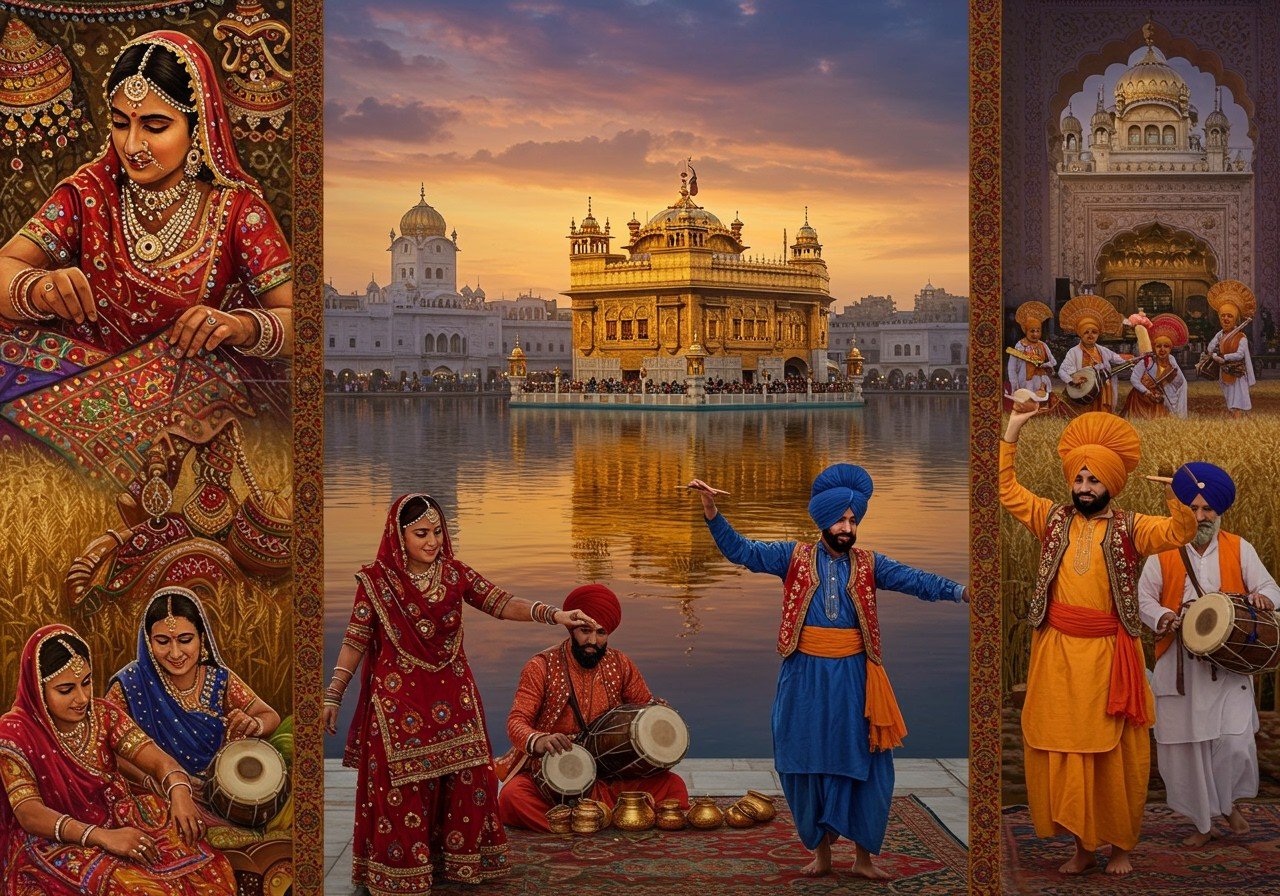
Punjab, a state in northwestern India, boasts a captivating cultural heritage shaped by its unique history and location. Bordered by Jammu and Kashmir, Himachal Pradesh, Haryana, Rajasthan, and Pakistan, Punjab’s culture reflects influences from various civilizations and traditions. This blog post delves into the rich tapestry of Punjabi culture, exploring its historical roots, vibrant traditions, diverse cuisine, captivating art and architecture, and evolving social structure.
Historical Roots
Punjab’s history spans millennia, marked by the rise and fall of empires and the confluence of diverse cultures. The Indus Valley Civilization (c. 2500 BCE), one of the world’s oldest urban cultures, flourished in the region, leaving behind archaeological marvels like Harappa and Mohenjo-Daro. The Vedic Period saw Punjab known as Sapta Sindhu, “the land of seven rivers,” shaping its agricultural identity. The Maurya and Gupta Empires further enriched the region’s cultural landscape. The arrival of the Sikh Gurus profoundly impacted Punjab’s spiritual and cultural ethos, leading to the establishment of the Sikh faith. Islam’s advent introduced new architectural styles and cultural practices, while the British colonial era left a lasting impact on Punjab’s socio-cultural fabric. Post-independence, Punjab witnessed a resurgence of Punjabi identity and cultural revival.
Cultural Practices
Punjab’s cultural practices are a vibrant expression of its people’s spirit. Baisakhi, the harvest festival and Punjabi New Year, is celebrated with great fervor. Traditional weddings are elaborate affairs, often incorporating the Anand Karaj ceremony. Bhangra and Giddha, energetic folk dances, showcase the region’s joyous spirit. Punjabi literature, with luminaries like Waris Shah and Shiv Kumar Batalvi, holds a special place in the hearts of Punjabis. Traditional attire, including Phulkari embroidery and the Patiala salwar, are integral to Punjabi identity. Music, ranging from folk to contemporary genres, plays a vital role in cultural expression. Agriculture remains the backbone of Punjab’s economy and way of life.
Cuisine
Punjabi cuisine is renowned for its rich flavors and hearty dishes. Staples like Makki di Roti (cornbread) and Sarson da Saag (mustard greens) are deeply rooted in the region’s agricultural heritage. Dairy products, such as paneer (cheese) and ghee (clarified butter), are essential ingredients. The Tandoor oven, used for cooking various meats and breads, has earned international acclaim. Langar, the community kitchen tradition, embodies the Sikh principles of equality and sharing. Seasonal ingredients from Punjab’s fertile lands influence culinary choices. Sweets like Jalebi and refreshing drinks like Lassi add a touch of sweetness to celebrations and everyday life.
Art and Architecture
Punjab’s art and architecture showcase a blend of historical influences and regional styles. The ancient ruins of Harappa and Mohenjo-Daro offer glimpses into the architectural prowess of the Indus Valley Civilization. The Golden Temple in Amritsar, a beacon of Sikh architecture, stands as a testament to faith and artistic brilliance. Mughal influences are evident in monuments like the Shalimar Gardens. Traditional art forms like Phulkari embroidery and Pahari miniature paintings continue to be cherished. Colonial-era buildings add another layer to Punjab’s architectural heritage. Modern developments often incorporate traditional elements, showcasing the ongoing evolution of art and architecture in Punjab.
Social Structure
Punjab’s social structure has evolved over time, reflecting historical and cultural shifts. The traditional joint family system emphasizes strong familial bonds. Community life plays a significant role, fostering a sense of solidarity among Punjabis. Rural-urban migration has influenced social dynamics and cultural practices. Women hold important positions in Punjabi society, contributing significantly to both culture and economy. Educational institutions play a crucial role in shaping modern Punjabi identity, balancing progress with the preservation of traditions. Globalization has further impacted Punjab’s social structure and cultural practices, leading to a fusion of old and new.
How Poojn.in Supports Your Punjabi Cultural Journey
Poojn.in, India’s leading online store for cultural and religious goods, offers a wide range of products to help you connect with Punjab’s rich heritage. Explore our collection of:
- Brass Karahi: Perfect for preparing Langar, the traditional community meal, these sturdy brass pots are essential for Punjabi households and Gurdwaras. Available in various sizes to suit your needs.
- Rumala Sahib: Show reverence to the Guru Granth Sahib with our pure cotton Rumala Sahib cloths, available in a variety of colors and designs. These cloths are essential for covering and protecting the Sikh holy scriptures.
- Brass Aarti Thalis: Enhance your prayer rituals with beautifully crafted brass Aarti Thalis, featuring intricate Punjabi designs. These thalis are perfect for holding diyas, incense, and other puja essentials.
- Five K’s Sets: Embrace the Sikh principles with our curated sets of the Five K’s (Kesh, Kangha, Kara, Kachera, and Kirpan), crafted with utmost care and respect for tradition. Choose from various materials and styles.
- Chaur Sahib: Find authentic Chaur Sahibs, traditionally used for fanning the Guru Granth Sahib, made from high-quality materials. These ceremonial whisks are available in various designs.
Visit www.poojn.in today to discover our complete collection of Punjabi cultural and religious items. Our customer service team is available to assist you with any questions.
Conclusion
Punjab’s cultural history is a testament to its resilience, adaptability, and vibrant traditions. From ancient civilizations to modern times, Punjab’s culture has evolved while retaining its unique character. By understanding and appreciating Punjab’s rich heritage, we can contribute to its preservation and ensure that its vibrant traditions continue to flourish for generations to come. Explore the cultural richness of Punjab and connect with its deep-rooted values through Poojn.in’s curated collection.
FAQs on Punjabi Culture
What defines Punjabi culture? Punjabi culture is a vibrant blend of traditions, including energetic dances like Bhangra and Giddha, rich cuisine, colorful festivals, and a strong sense of community.
How has history shaped Punjabi culture? From the Indus Valley Civilization to the Sikh Empire and British rule, Punjab’s history has significantly influenced its cultural practices, languages, and social structures.
What are some important Punjabi festivals? Baisakhi, Lohri, and Diwali are among the most important festivals celebrated in Punjab, each with its unique traditions and significance.


